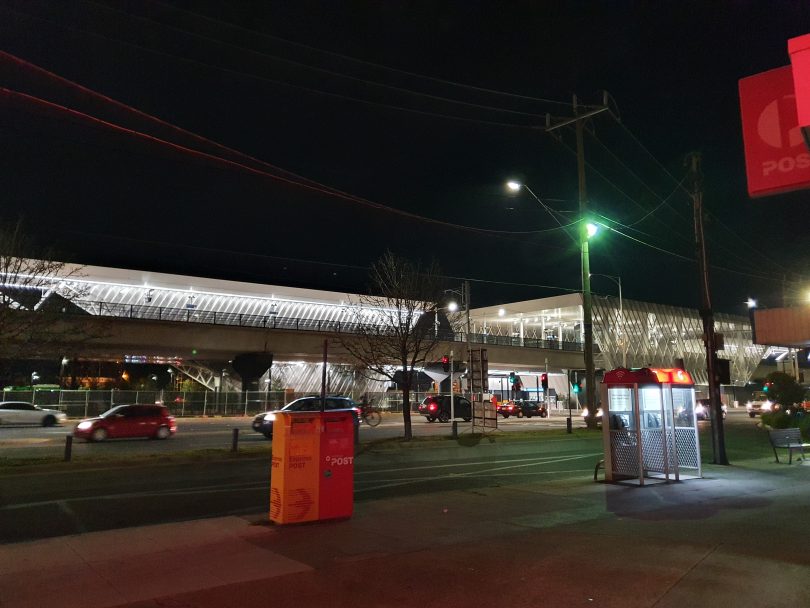The new Reservoir Station in Victoria’s Mernda line looms as a constant reminder to the local traders. Liam Webster Mcallister writes about the effect construction of the new Reservoir Station had on the local businesses. Last December 16, was the opening of the new Reservoir elevated railroad. It was a $232 million construction. It is unmissable. But the local businesses ultimately paid a hefty price.

Reservoir Station’s imposing presence (Photo: Liam Webster Mcallister).
For Simon, the local Lotto owner, the new station is a reminder of the struggle he went through, keeping his business open and the fellow trader the local community lost. This construction – when combined with the coronavirus outbreak has resulted in a disastrous period for the local businesses. One local beloved trader recently took his life. His business is one that my father and I have visited many times and knew the owner very well. And although we cannot pinpoint what it was that drove him to do so, you cannot help but feel the last harrowing 15 months played a role.
The elevated railroad stretches a kilometre long and stands at over nine metres high. It is hard to not marvel at its impressive design. But when you dig deeper, its cracks appear. Late 2019 saw major railroad constructions in Melbourne’s northern suburbs. Reservoir Station was the latest to be moved to an elevated railroad.
It came as no surprise when the Level Crossing Removal Authority announced plans to construct an elevated railroad. The congested location was ranked the third worst level crossing in Melbourne, according to a 2014 RACV Red Spot Survey. In the ten years leading up to the construction, the level crossing had experienced, three recorded collisions, a fatality and twenty-six near misses, according to the Premier, Daniel Andrews website. The Acting Premier at the time, James Merlino, described the level crossing as a “notorious bottleneck in the heart of Reservoir.” Approximately 36,000 vehicles travel daily through the Reservoir junction, however, due to the constructions this drastically reduced.
Broadway Lotto owner Simon Alan described the challenge keeping his businesses open with a huge reduction in traffic. “Our rent stays the same, our overheads stay the same, our wages stay the same, with 75 per cent reduced traffic,” he told me. “What people don’t realise is we are not just shop owners, we are family members, we’re fathers, grandfathers, we’re mothers, grandmothers, we’re part of the community, we still need to be able to survive and put food on our table.”
Susan Rennie, Darebin City Mayor, spoke with me about the construction of the Reservoir Station and its impact on local businesses. The mayor described the station prior to construction as a “significant barrier” for locals trying to access shops on both sides of the railway line. She also shed some light on the uncertainty surrounding funding provided to the local traders. “The State government was not able to provide any specific financial support of the type many traders were asking for,” she told me. The lack of financial support made it difficult for businesses. But the mayor believes the more effective design will “enhance the area’s amenity and increase the number of people inclined to visit.”
I contacted the Major Transport Infrastructure Authority (MTIA) to develop a deeper understanding of the station since it opened. As of May 31, 2020, there has been 330,000 myki touch on/offs at the station since its opening on December 16, 2019, according to the MTIA. They also outlined the continued works on the station. “Finishing works are continuing, with the installation of permanent stairs and lifts at the station, as well as landscaping works around the station precinct and reinstatement of the bus interchange in early June. Car parking and the new shared-use path will be complete in July.”
A media release by the government on October 23 of last year said, “The removal of the level crossing will also benefit local businesses, who continue to receive targeted support from the project during the disruption.” This is far from reality. Local business became a casualty of a badly prepared project.
The MTIA provided me with a rundown of the measures that were taken to help the local traders. The measures included shop local promotions, business health checks and competitions encouraging people to shop locally to name a few. However, no direct financial support was provided. At approximately 3 pm August 19 of last year, outraged local business owners took to the tracks at Reservoir Station to have their voices heard. My train that day was held up by the protests, leading me to question if this station was doing more destruction than construction? Albeit short the eight-minute hold up received widespread attention from notable media outlets.
But unfortunately for Simon and his fellow traders, the protest had no effect. “Seriously nothing, we wasted time,” he told me. The government did not respond to this plea for some financial help. The Darebin Council did what it could to help the local businesses and even tried to help the traders contact the government. Twice the council reached out to the government. According to Darebin City Council’s Minutes from October 14 of last year, there is a letter outlining potential solutions put to the Premier.
The letter from the Mayor of the Darebin City Council, Susan Rennie, demanded solutions such as “rent relief for the businesses or marketing assistance and business support for the precinct.” The Victorian Premier, Daniel Andrews, did not reply to either letter. Instead, Daniel Andrews announced on October 23 of last year, that the crossing would be removed by Christmas. But the construction caused major blockages for approximately four months according to the Darebin City Council’s Minutes from November 6. This was spanning from August 19 when major construction began to the opening of the new station on December 16.
Local businesses were left to fend for themselves with some assistance from the Darebin City Council, who tried promoting on their social media the local businesses in the affected area. They also tried upfront methods such as electronic signage to try and direct motorists to the shops in the area. The council boosted activities and events in the area to try and get more people visiting, and even offered marketing workshops.

Flyer displaying the business marketing workshops offered (Darebin City Council).
Marketing workshops, however, are futile for traders like Simon who have been running successful businesses for over 15 years. “I know my customer when he walks in, what he smokes, what he doesn’t smoke, what he plays, what he doesn’t play, what drink he has what chips he eats,” he told me. “I know that and I have it pre-ready when I see them parking their car I get their stuff ready for them.”
The 20 minutes I spent talking to Simon was evident of this. He would regularly have to attend to customers throughout the interview. And although that is nothing out of the ordinary his understanding of his customers was. Most of his customers would stop for a chat and Simon often knew what they wanted without them saying anything. But these businesses need more than just local customers. “We don’t just rely on our locals we have a lot of passing traffic,” he told me.
Simon throughout the interview many times got extremely angry just recalling what happened and the rage in his eyes was immense. And as disappointed as he was in the lack of financial support, his biggest problem was that he blames the construction as a factor in the local trader taking their life. “The unfortunate part was, don’t worry about the money we lost, it’s the life we lost. “What amount of money, can bring [them] back.” There is no argument the construction was necessary, but it is the handling of it which was the problem.



